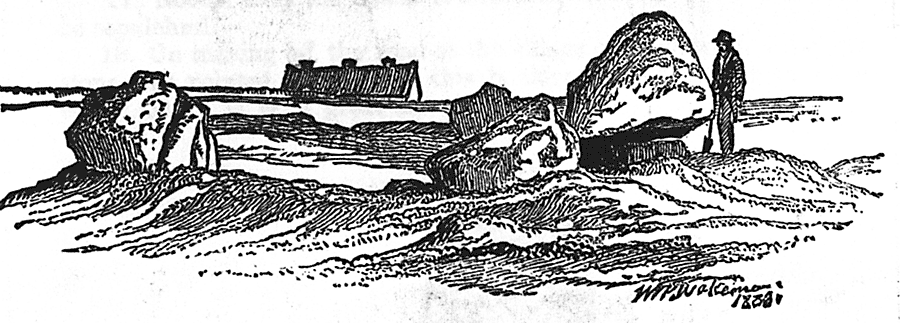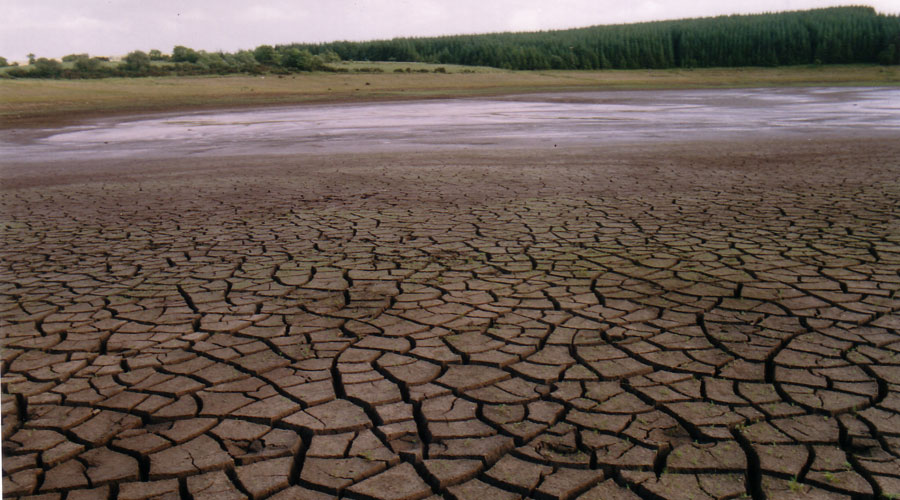The Second Battle of Moytura
The Second Battle of Moytura was a complex affair, with many interwoven sub plots to the story, and needs background information to make sense of it. The Battle was fought on the high plain of Maigh Tuireadh which stretches from Heapstown and Lough na Suil to Kilmactranny, and lies to the east of Lough Arrow in Co Sligo. The great neolithic complex of is located on the highest points of Carrowkeel and Kesh Corran to the west. The Battle took place between the Túatha Dé Danann who represent the forces of Light and Order versus the Formorians who represent Darkness and Chaos.During the kingship of the Firbolg, an uneasy alliance was held between that tribe and the Formorians, and they lived in Ireland without strife. However, the Túatha Dé Danann and the Formorians knew each other before the Battle, and though the Formorians are described as a hideous race, two of the most beautiful members of the Túatha Dé Danann, Breas and Lugh were half Formorian. There was an enmity between the two tribes, which in part led to the Battle.
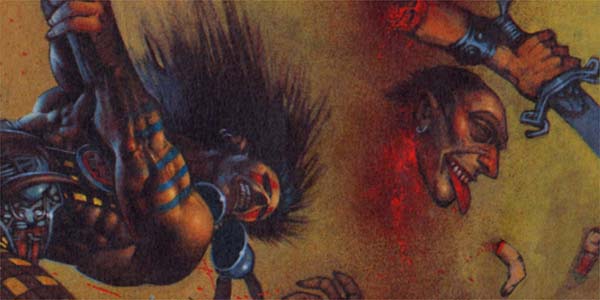
The plateau of Kilmactranny is covered with hoary weathered lumps of limestone and many ancient monuments - none of which have been subjected to a scientific excavation. The sites consist of several cairns, a dolmen, a ruined stone circle, a fine ruined court cairn, many ringforts and cashels, and several monuments which are difficult to classify. The highest point of the ridge is occupied by the cairn of Shee Lugh shown below. Lady Louisa Tennison 'examined' the mound in the last century; there is no record of her excavations, and the chamber buried with no indication of it's orientation.
Whatever about that, Shee Lugh is a fitting seat for the Sun God as it commands one of the finest views in Co. Sligo, even though it is not especially high - 228m above sea level. All the cairns of Sligo can be seen from here, and the mound is a superb place to watch the rotation of the heavens. From Shee Lugh the summer solstice sunset drops behind Knocknarea Mountain to the north west. On the winter solstice, the sun sets over Carrowkeel. On the winter solstice, the sun rises in the region of Sheemor in Leitrim; and on the equinoxes the sun rises over Sliabh an Iariann in the east, and sets over Muckelty Hill in the west.
So then we shall begin the tale of the Second Battle of Maigh Tuireadh. After the Battle of Cong, Breas the Beautiful was elected High King of the Túatha Dé Danann. However, as mentioned he was a child of the two tribes - his father was Elatha, a Formorian king while his mother was a princess of the Túatha Dé Danann.
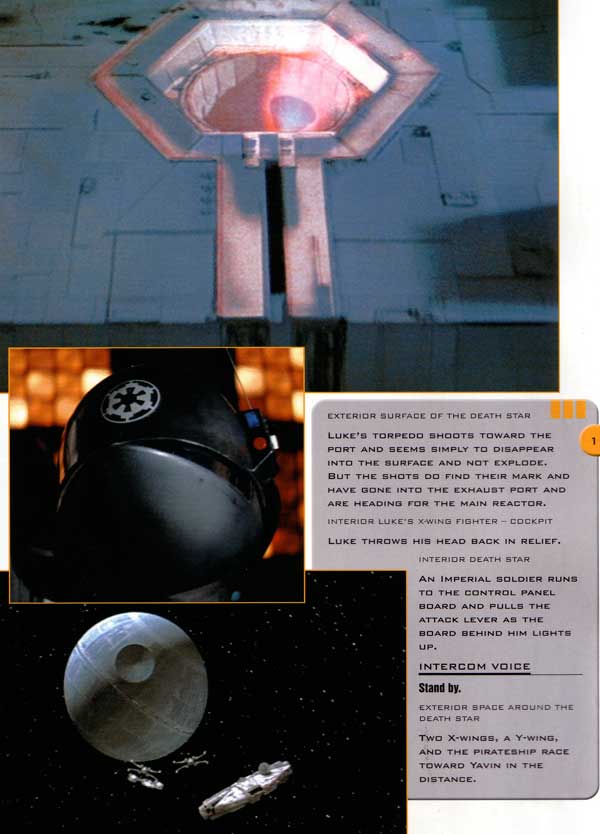
Núada had been deposed and withdrew to his dun at Naas; and Breas took over the kingship at Tara. Though very beautiful to look at, Breas was both proud and greedy, and he began his reign by increasing taxes and squeezing money and labour out of his subjects. He soon proved unpopular among his people 'for their knives were not greased by him'. Breas also allowed his father's people, the Formorians to enter Ireland and oppress the Túatha Dé Danann with heavy taxes and violence.
Breas had a love for the west of Ireland, and set the Dagda to work to build a dun for him on the ridge of Maigh Tuireadh. The Dagda is renowned in Irish mythology as a great builder and musician. However, he received poor pay and food for his work, and worse, an idle blind man named Cridenbel kept complaining that his food is not enough and asking the Dagda each night for the three best bits from his meal. After a few days of this, the Dagda was weak from hunger.
As he was down digging a trench for Breas's fort, his son Aongus Og came along, and asked him why he looked so unwell. He advised to the Dagda to put three pieces of gold in his meal, and give these to Cridenbel when he asked for the three best bits. The Dagda followed Aongus's advice, and Cridenbel ate the gold, choked and droped dead. Breas accused the Dagda of murder; the dead man's stomach was cut open, the truth revealed and the Dagda cleared.
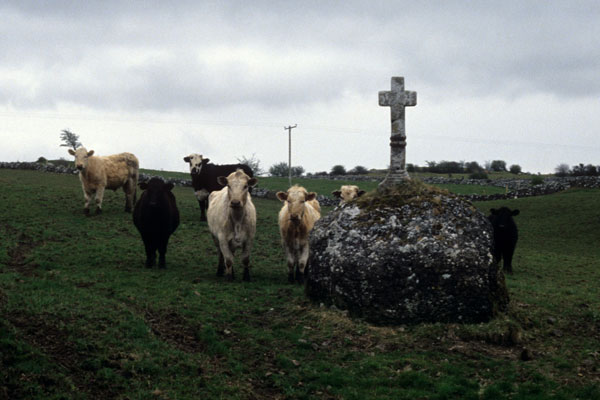
The poet of the Túatha Dé Danann, Coirpre, went to visit Breas, and received very poor hospitality from him. A poet was ranked next to a king; yet Breas had Coirpre installed in a hut with no fire, furniture or bedding. When his meal came it was three small, dry cakes of bread. Coirpre, rightly outraged at his treatment, composed to first satire ever uttered in Ireland for Breas, which caused three ugly red blotches to erupt on the king's face.
- Without food quickly on a dish,
- Without cow's milk on which a calf grows,
- Without a man's habitation after darkness remains,
- Without paying a company of storytellers - let that be Breas's condition.
Soon after Breas was 'sacked' by the Túatha Dé Danann, and left Ireland with his mother to seek the aid of his father's tribe, the Formorians.
Núada was reinstated as High King when he got a new Silver Arm. The story goes that Dainceacht the healer made several attempts to heal and repair Núada's arm, but to no avail. Then his son Miach, who seems to have had superior scientific healing skills created a technologically advanced Silver Arm which he fitted to Núada. It was a marvellous piece of work, with sinews and bone of silver which he melded with Núada's living tissues. The King was whole again and was restored as ruler of the tribe.
However Dainceacht became jealous of his sons powers and attempted to kill him in a fit of rage. Three times he struck Miach in the head with a blade, and the first two attempts Miach healed himself, but on the third he died. 365 herbs with healing properties sprang from his grave, which could cure all the ailments in Ireland; and Miach's sister Airmed sat down to sort them out on her cloak. But her father came along and again in a fit, he scattered the lot so today no-one knows all their uses. Dainceacht's role in the Battle is described at the Heapstown Cairn page.
The Arrival of Lugh
Lugh, the champion of the Túatha Dé Danann was also descended from both tribes. His mother was Eithne, the daughter of Balor and Caithleen. There was a prophesy that Balor would die by the hand of his own grandchild, and to ensure that this should never come to pass, he locked Eithne up in the glass tower on Tory Island, and commanded that she should never see or know a man. However, by way of an incident where Balor stole a magic cow from three brothers, one of the brothers named Cian ended up on Tory Island to recover his cow, and with the aid of a Druidess, he was taken to meet with Eithne. They lay together and conceived, and then Cian was whisked back to Ireland.
Balor fell into a dreadful rage when he discovered that his daughter was pregnant. She gave birth to triplet sons, and Balor commanded that they be thrown into a whirlpool; however, one of the babes was rescued by Manannan mac Lir, the god of the Sea, who raised him as his own son in the Land of Promise. This child was Lugh of the Long Arm, the Ildana of the Túatha Dé Danann.
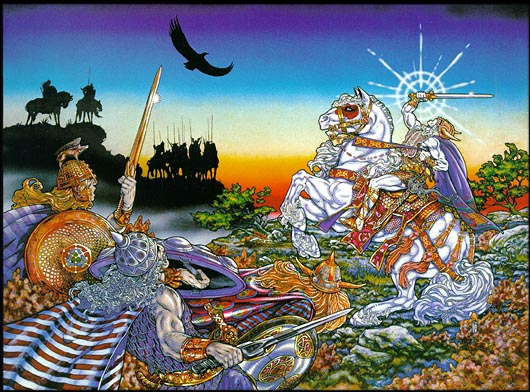
Lugh, the Ildana first made his appearance at Tara where Núada was back on the throne; Lugh asked to enter and the doorkeeper asked him what special skill he possesses. Lugh named off a number of skills and the doorkeeper went in to the King, only to be sent back each time with the message that there is already a member of the Túatha Dé Danann present with such a skill. After going through a great number of his talents Lugh became tired of the game and asked if anyone in the hall possessed all the skills which he had listed. As there was no one, he was admitted, and after several feats of strength and music, Núada was so impressed that he gave over his throne to Lugh for the duration of the battle.
Lugh next appeared on the Hill of Uisneach , the centre of Ireland where a fair was being held. He was mounted on Manannan's enchanted horse, and bore his armour, helmet and enchanted sword, 'the Answerer'. A group of Formorian tax collectors arrived and Lugh slayed eight nines of them, sending the survivors back to Balor with a message that they were not to enter Ireland again.
Balor was incensed, and sent out his armies to slay the the Dananns, and commanded them to tie Ireland to their ships and drag the island into the icy North Sea. Breas lead an army which landed at Ballisodare and proceeded to ravage the province of Connaught. Lugh met them in battle, and after three days fighting they resolve to meet at Maigh Tuireadh to settle the matter once and for all. The date they agreed on was Samhain, the beginning of the new year.
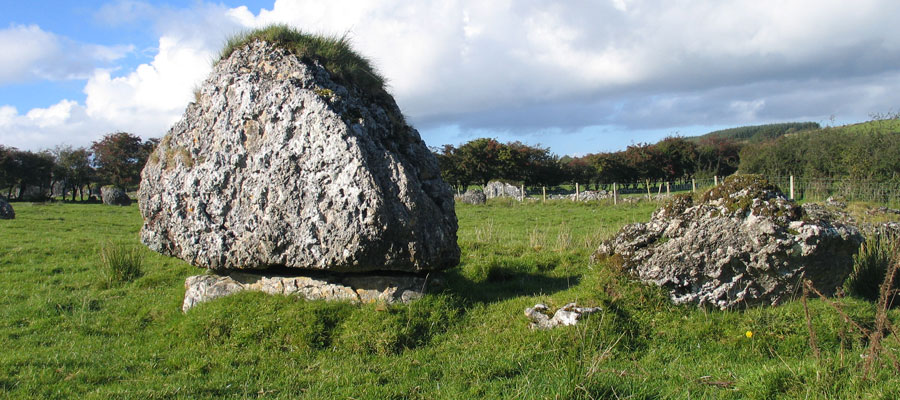
Lugh returned to Tara and assembled his army. The Dananns made their way across to Sligo for the Battle. Balor led a massive army down from Tory Island by sea - a veritable bridge of ships. The Formorian fleet landed at Screen, about ten miles west of Knocknarea and made their way down to Maigh Tuireadh.
The modern village of Dromaheir in Leitrim is associated with Balor and is said to mean The Ridge of the Two Demons; however, Michael Quirke has pointed out, it can be translated as The Ridge of the Two Easts, for it is here that Balor saw a great light in the east and exclaimed that the sun had already risen - the light was from Lugh Lamh Fada, the Shining One, watching the arrival of his grandfathers army.
The Battle took place at Samhain on the ridge of Maigh Tuireadh. The two armies assembled and the bloody slaughter began. There was fierce fighting and heroic deeds from both sides, but the deadly power of Balor's Eye wrecked havoc and destruction among the Túatha Dé Danann. Lugh was kept apart from the fighting and surveyed the field from his cairn, Shee Lugh on the highest point of the ridge surrounded by a protective bodyguard. He was considered too valuable to fight in the Battle.
Giobnu the smith had a forge down by the shores of Lough Arrow in Annaghgowan, and he was kept busy making and repairing weapons for the Túatha Dé Danann. Dainceacht, Airmed and Octruil were casting spells into their healing well at Achad Abala, near the River Uinshin by the northern tip of the lake. The healers stood about the well, casting herbs and enchantments along with slain and injured warriors of their tribe into the waters. The soldiers of the Túatha Dé Danann would emerge whole again from the well and return immediately to rejoin the Battle. And so it raged on.
The Irish Celtic Magical Tradition', Steve Blamires, 1992
Núada was killed in combat with Balor, and he is said to be buried with Macha under the Labby Rock, the massive portal dolmen shown above. At this stage Lugh leaped over his bodyguard and with Manannan mac Lir's sword, The Answerer, entered the combat with deadly effect. He preformed a shamanic crane dance where he hopped around the Formorian army three times on one leg with his eye covered, before engaging his grandfather Balor in single combat. Lugh used a rock, spear or sling in different versionsof the tale to pierce Balor's eye, killing him instantly along with a large number of Formorians warriors who were standing behind him.
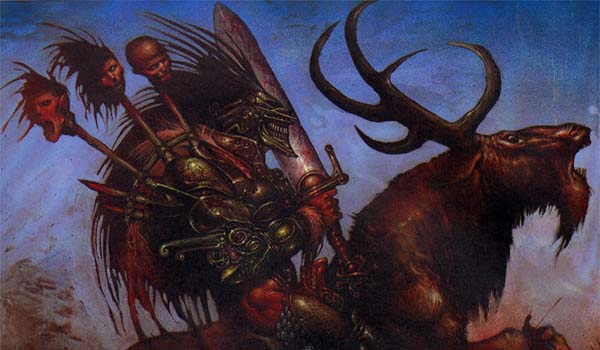
As the venomous eye fell from Balor's head, it burned a great hole in the ground and entered the earth forming the eerie Lough na Suil, the Lake of the Eye which lies at the north end of the Battlefield. At this point Breas surrenders to Lugh and the battle becomes a rout, with the Formorians beaten back into the sea.

There followed several short sequils to the Battle. Lugh spared Breas's life in exchange for information about farming, one of the few skills the Túatha Dé Danann did not possess. The Formorian poet gives an account of the number slain in the Battle, and the Dagda sets off to recover his stolen harp. The tale is concluded by the Morrigan, the Great Queen and Goddess of Battle, as she chants poetic prophesies about the future of Ireland:
- Peace up to heaven.
- Heaven down to earth.
- Earth beneath heaven,
- Strength in each,
- A cup very full,
- Full of honey;
- Mead in abundance.
- Summer in winter....
- Peace up to heaven....
And the end of the world:
- I shall not see a world
- Which will be dear to me;
- Summer without blossoms,
- Cattle will be without milk,
- Women without modesty,
- Men without valour.
- Conquests without a king....
- Woods without mast.
- Sea without produce......
- False judgements of old men.
- False precedents of lawyers,
- Every man a betrayer.
- Every son a reaver.
- The son will go to the bed of his father,
- The father will go to the bed of his son.
- Each his brother's brother - in - law.
- He will not seek any woman outside his house.....
- An evil time,
- Son will deceive his father,
- Daughter will deceive.......

